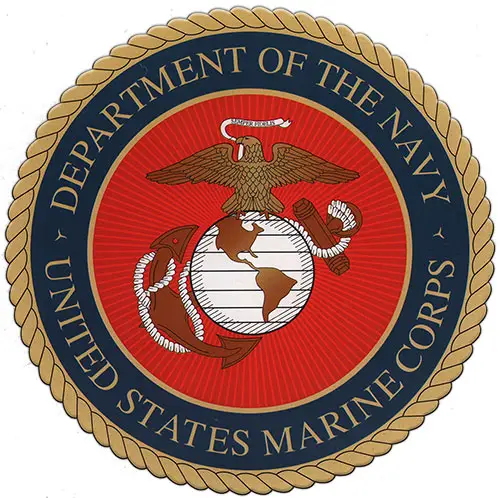United States Marine Corps Mental and Moral Qualities

Emblem of the United States Marine Corps - A Department of the US Navy. GGA Image ID # 137462cb94
THE MENTAL AND MORAL QUALITIES of the United States Marine have been tested constantly since the birth of the Nation. All through the long history of the Marine Corps there are examples, both in war and peace, of his versatility, trustworthiness, singleness and tenacity of purpose, courage, faithfulness and self sacrifice.
The rich tradition of the Corps dates hack to November 10,1775, when it was established by the Continental Congress In the Revolutionary War, the Marines fought against the British Fleet on the ships of John Paul Jones, and made their first amphibious landing on the beaches of the Bahamas in 1776.
Marines ended the war in the Mediterranean with the Barbary Pirates when they planted the Stars & Stripes over the pirate stronghold of Deme, Tripoli, after a six-hundred mile march across the desert of North Africa. In the War of 1812, they fought on Lake Champlain and Lake Erie, and were with General Jackson behind the barricades at New Orleans.
They defeated the Seminole Indians in the dense swamps of Florida in 1836, and fought under General Scott in the Mexican War of 1846-48. Their first visit to Japan came in 1854 as guard detachments from the ships of Commodore Perry’s fleet. Under the command of Colonel Robert E. Lee, U.S.A., Marines captured John Brown at Harper’s Ferry in 1859.
Marines served both ashore and afloat during the American Civil War, fighting in such battles as Bull Run, Cape Hattarass, New Orleans, Charleston, and Fort Fisher.
They fought savages in Formosa in 1867, and stormed the barrier forts of Korea in 1871. During the Spanish American War, a single battalion of Marines held the Naval base at Guantanamo Bay, Cuba, against 6,000 Spaniards, while other leatherbacks distinguished themselves at the Battle of Santiago and with Dewey at Manila.
They helped quell the Boxer Rebellion in China in 1900, and from then on until World War 1, men of the Corps campaigned in the Philippines, Cuba, Mexico, Haiti, and Santo Domingo to protect American lives and property.
On the battlefields of France, Marines were called “Devil Dogs” by the Germans because of their courage and tenacity of attack. In the first World War, the Fourth Brigade of Marines took part in five operations as part of the famed Second Division of the A.E.F. Belleau Wood, Soissons St. Mihiel, Champagne, and the Meuse-Argonne Marine units were decorated six times by the French during these campaigns, and Marine aviation came into its own.
The interim between the world wars found the Marines engaged in developing the technique of amphibious warfare and in théir traditional pursuits around the globe, from guarding the U.S. mails to fighting bandits in Nicaragua.
World War II saw the men who wear the eagle, globe, and anchor valiantly defend Wake Island and Bataan and then spearhead the amphibious landings across the Pacific... in the Solomons, at Tarawa, Saipan, Guam, Iwo Jima, and Okinawa, to name a few.
While Marine units participated in the post-war occupation of Japan and northern China, a new type of service began— duty with United Nations Forces in Korea. In September 1950, Marines left the Puson perimeter to storm the beaches at Inchon and later, fought the Chinese in the frigid cold to the north at the Chosen reservoir.
The end of the decade saw Marines land in Lebanon in July 1958 to restore order there, and again in April 1965 in the Dominican Republic to protect and evacuate Americans trapped in the midst of the violence.
Large-scale U.S. involvement in Southeast Asia began in 1965; and for six years Marines fought Communist aggression in the mountains, jungles, and rice paddies of South Vietnam, where new honors were won at places like Khe Sanh and Hue City.
Marines made their presence felt worldwide throughout the 1970’s as they evacuated embassy staffs, American citizens, foreign nationals, and refugees in Cyprus, Cambodia, and the Republic of Vietnam, and played a crucial role in the rescue of the crew of the SS Mayaguez.
In the last decade, Marines served with distinction at embassies around the world in the face of increasing terrorist attacks. They were part of the U.N.’s multinational peacekeeping force sent to Beirut, Lebanon, in August 1982, and were called on to intervene in Grenada in October 1983 and in Panama in December 1989 to protect American lives and restore the democratic process in those nations.
By virtue of their expeditionary nature and forward deployment, they were chosen to conduct numerous noncombatant evacuations of civilians and diplomats, as well as to offer humanitarian assistance to people in need in war tom countries and in areas of the world struck by natural disasters.
Most recently, in August 1990, both regular and reserve Marines were called upon to defend Saudi Arabia from Iraqi aggression and later, in February 1991, to threaten an assault from the sea while breaching Iraqi defenses in the liberation of Kuwait.
The United States Marine Corps, rich in tradition, world-famed for its battle record, envied for its esprit de corps, and respected for its professionalism, continues to play an important role as the Nation’s “force-in-readiness” in preserving the American way of life and protecting our citizens, property, and interests abroad.
